by
Harry L. Cook, Azmi b. Abd. Rahman, L.D. Rajamanickam
and Md. Nafiah b. Md. Yasin
| ABSTRACT |
| The paper describes a system of water management for tidal aquaculture ponds. Screens are used at multiple points, with a progressively smaller screen at each point. Advice is given on how to construct screens with different screening materials. The use of woodboards to set up an oblique flow across fine mesh screens is described. A circular flow is set up between a board and the fine mesh screen which makes the screen essentially self cleaning. |
Water for aquaculture ponds must be screened to prevent predators and competitors from entering and to keep the crop being cultured from escaping. This is often a problem if the organism being cultured is small and/or the amount of water to be exchanged is large. The most common problems are that screens become clogged and break, or that small fry being cultured are pressed against the screen by high flow rates, and die.
At the Brackishwater Aquaculture Research Centre, Gelang Patah, problems related to acid sulphate soil require that the pond water be exchanged frequently. If the pond water is not renewed regularly its quality deteriorates rapidly. The station has no nursery tanks so penaeid shrimp have to be stocked at a small size. For these reasons special attention was given to developing a method of exchanging large volumes of water. A system was devised with screening at multiple points with progressively smaller screens at each point. Appropriate management practices were developed at the same time.
The pond system at the Brackishwater Aquaculture Research Centre consists of 33 ponds ranging in size from 0.05 to 2 ha. The water surface area of the ponds is about 13 ha. There are two culvert-type main gates, each with two lanes. Two main canals are connected by secondary canals. The pond gates are also a culvert-type and have monks at each end. Each monk has three 5-cm grooves spaced 5 cm apart for holding screens and wood boards, in addition to a gate which is operated by turning a spindle (Fig. 5a).
The system is well designed for tidal exchange. Pond bottom elevations are 30 cm and 45 cm above mean sea level. Mean tidal amplitude varies from 2.9 m during spring tides and to 1.1 m during neap tides. Water in the ponds is normally maintained at a depth of 1.0 m. Whenever tidal conditions permit, the usual practice is to draw off and replace 50 percent of the water daily in ponds in which culture is underway.
Screens at the main gate are intended to keep large pieces of debris out of the water system of the farm. As substantial volumes of water pass through the gate at great speed the screen must be strong. A screen made from 7 mm polyethylene rope woven to make 3 in (7.6 cm) openings (Fig. 1) worked well. For greater strength and ease of handling it is suggested that the screens be no higher than 1.5 m with one cross brace. In areas where tidal fluctuation is large two or three screens can be used in one gate.
The frame was made from 4 × 7.5 cm wood with half-lap joints fastened by brass screws. Holes 9 mm in diameter on 7.6 mm centres are drilled along the frame. No hole is drilled at the cross brace. The holes are 2 cm from the interior edge. This leaves an outer edge large enough to fit into the groove of the sluice gate without damaging the rope. The rope is inserted in a hole at one corner of the frame and tied. It is then threaded loosely through all the holes from side to side. The ropes running from top to bottom are woven through the horizontal ones. The rope is pulled taut one section at a time by pulling it tight and using a wood peg to keep it in place until the next section is tightened. At the end the rope is tied off again.
One of the problems encountered when using culvert-type main gates without screens is that a vortax forms which sucks floating surface debris down into the culvert. These screens serve as an anti-vortax baffle. This means that not only is floating debris prevented from entering the pond water system, but low salinity surface water is no longer drawn down. This is specially important after heavy rains when high salinity water is desired.
The objective of placing a screen in the main canal is to catch floating debris such as mangrove leaves which pass through the screen at the main gate. This net screen is simply a net stretched across the water canal at the high water level (Fig. 2). It extends to 1 m below the waterline when the canal is at full level. As the net catches debris and becomes clogged, water can still flow under the net while floating debris continues to be caught. Water coming through the main gate is very turbulent, consequently, it is necessary to place the screen far enough from the main gate where the flow is linear and the debris has a chance to rise to the surface.
The net is 1.5 m high and wide enough to extend across the canal. The top of the net is located at a point 0.5 m above the expected water level during water intake. It was not found necessary to extend the net completely across the canal. Water current is slow along the edge and if an open space is left there no great harm is done. The net is fastened in place by putting two large posts in the canal at the end of the net. The wood supports at the end of the net rest against the posts when the net is stretched tight and tied to a stake on the dike.
If the same canal is used for both filling and draining it is not necessary to clean the net every day. The back flushing action during draining washes the net and carries the debris out of the canal. If the canal is used only for taking in water, the screen should be cleaned every day. The net is brought to one side of the canal for cleaning. This is best done after water flow in the canal has been reduced so that there is just enough pressure on the net to keep the debris in place. A piece of rope long enough to stretch across the canal is attached to one end of the net. A weight is tied to the end of the rope so that it can be thrown across the canal. One person throws the weighted rope across the canal where a second person takes it and pulls the net into the dike where it is cleaned.
Two screens are used in the pond gate. One large mesh (2.5 cm) screen is placed on the canal side throughout the culture period to keep out large debris. A small mesh screen is used on the pond side to keep out predators and competitors and keep in the cultured fish or shrimp. As the cultured organisms grow, the mesh size of the inside screen is changed periodically to a large size to facilitate water exchange and facilitate cleaning.
Frames for the screens are made from 4 × 7.5 cm wood with half-lap joints fastened by brass screws (Fig. 3). The frames are 1.5 m high and two cross braces are used to support the screen material. The frames should be built to last a long time and be made from strong durable wood. The use of brass screws allows the frame to be taken apart for repairs if a side is broken accidentally. The screen material is held in place by a light wood moulding fastened with galvanized nails.
Several materials have been used for pond gate screening. Stainless steel was found to undergo electrolysis in the pond water, and galvanized iron rusted rapidly. Polyethylene screen netting in mesh sizes from 2 to 5 mm was found to be durable and easily cleaned. It, however, is not generally available in Malaysia and has to be imported. Two mesh fabrics made from nylon were available at local fabric shops. Both materials are interwoven (not woven simply like the polyethylene) which makes them extremely strong and durable. One, nylon inside belt, is a material which is used to stiffen the waistband in men's trowsers. It has a mesh opening of approximately 1 × 1.5 mm. The second is nylon carpet net used to make carpets. It has mesh openings of two sizes: 2 × 4 mm and 4 × 7 mm.
Screens made from fish netting are effective, especially where large meshes are required, such as on the canal side of sluice gates and ponds where large fish are cultured. Screens made from 2.5 cm polyethylene have been in continuous service for more than one year.
Screens of fish netting use the standard frame (Fig. 3). The key in making a good tight screen from fish netting is to stretch the netting properly on the frame. The netting is not cut by stretching the net to a length corresponding to the length of one side of the screen, but by calculating the number of stretched meshes required; that is the distance from knot to knot when the mesh is fully stretched. One of the most important factors to consider when calculating the number of meshes required is the hanging ratio. It is suggested that a hanging ratio of 0.3 be used as that gives equal stretching to all four sides of the mesh.
To calculate the number of meshes required to make a screen the height and width of the stretched netting required correspond to the height and width of the outside of the frame. Any excess will help in stretching the netting tight and can be trimmed if necessary. The method of calculating the number of meshes follows that presented by International Development Research Centre and Aquaculture Department, Southeast Asian Fisheries Development Centre (1979).

where s = the hanging ratio.
Since it is best to use a hanging ratio of  can be solved and the product
0.71 used as a constant. The formula is then simplified to:
can be solved and the product
0.71 used as a constant. The formula is then simplified to:

To calculate the number of meshes required, the length of stretched netting is divided by the mesh size. Care must always be taken to use the same units of measure, i.e., centimetres with centimetres or inches with inches.
Following is an example using a 182 × 99 cm screen frame. Mesh size is 3.8 cm and hanging ratio is 0.3
| 1. | Length of stretched netting required for width | 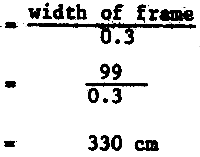 |
 | ||
| 2. | Length of stretched netting required for length | 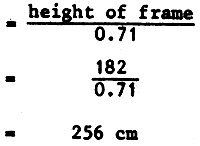 |
 | ||
Since this calculation is complicated, the following table can be used for easy reference to obtain the length of stretched netting required.
| Frame measurement (cm) | Length of stretched netting material required | |
| for width (cm) | for height (cm) | |
| 80 | 267 | 113 |
| 90 | 300 | 127 |
| 100 | 334 | 141 |
| 110 | 367 | 155 |
| 120 | 400 | 169 |
| 130 | 433 | 183 |
| 140 | 467 | 198 |
| 150 | 500 | 212 |
| 160 | 533 | 226 |
| 170 | 567 | 240 |
| 180 | 600 | 254 |
| 190 | 633 | 268 |
| 200 | 667 | 282 |
The next step is to count off the number of meshes on the netting and cut off the piece of netting needed. Once the netting is cut to the proper size it is stretched on the frame. To do this a nail is put in one corner of the frame to hold the netting. Then the netting is stretched along one side of the frame and fastened with staples. The netting is then stretched across the top of the frame and pulled tight. The next step is to fasten the net along the other side. Finally, the net is fastened along the bottom. Lastly, the moulding is put in place with galvanized nails.
Netting made of fine twine tends to pull out from under the moulding. This can be prevented by cutting a groove (8 mm deep and 12 mm wide) into the frame to aid in fastening the netting. After the netting is cut to the proper size a piece of rope is woven along the edge of the netting. The rope is then fixed into the groove and the moulding board is nailed on to hold it fast (Fig. 3).
Although installing the proper screens is an improvement, a good management programme must be developed to ensure that the system operates as planned. Probably the most important aspect is regular cleaning of the screens. A long handled brush should be kept by each interior screen, and the screen should be cleaned before the gate is opened. Periodic inspection during the water exchange is essential to clean the screens if they become clogged. This is most important when fine mesh screens are used. Due to the difficulty in keeping them clean, fine mesh screens should be used for as short a time as possible and replaced with larger mesh screens as the fry grow. Even though they are brushed regularly, it is difficult to get the lower portions of the screens really clean. To prevent the lower section from becoming blocked by attached algae or barnacles the screens should be removed, cleaned thoroughly and replaced with the top and bottom in reverse position once a week.
Most brushes have a hole drilled in the wooden top to hold the handle. This is not strong. It is better to cut a flattened notch in the brush head and nail the handle at right angles to the bristles of the brush (Fig. 4).
It is not always possible to supervise pond workers closely. To prevent misunderstandings it is better to give standardized written instructions. A form is used for this (Fig. 6). Every day the time and height of each tide are calculated using information from tide tables. The times at which the gates should be opened and closed are then determined and entered on the form. The remarks column is used for special instructions, such as how much water to drain and the level to which the pond should be filled. These will vary depending on the weather and size of shrimp/fish in the pond. To make sure the proper levels are achieved, an easy-to-read depth marker is placed in every pond. The reverse side of the form is used to illustrate the proper position of the boards and if they are to be used a note is made in the remarks column.
The fine mesh screens required when culturing small fry tend to become clogged in a very short time. A direct water flow presses detritus and trash up against the screen where it remains. It has been found that clogging of fine mesh screens can be minimized by using woodboards to cause the incoming water to hit the screen obliquely. If the pressure is great enough, soft eggs and larvae can be forced through holes they ordinarily would not pass through. With an oblique flow the trash is not pressed onto the screen, but washed along the screen with the flow. If the boards are placed properly a circular flow is set up between one of the boards and the screen, which makes the screen essentially self-cleaning. This system requires a gate with three 5-cm wide grooves spaced about 5 cm apart on the side next to the pond. The screen is always placed in the middle groove.
Woodboards of two sizes are used: one is 60 cm high and the other is 45 cm. The choice of size depends on the height of water in the pond and how much water is to be changed. The boards are constructed of 1.25 × 10 cm pieces of wood. A brace is put about 7.5 cm from each end to hold the pieces together. Each board has a long wood handle to insert and remove from the gate.
During the initial filling when the pond is empty two boards are placed in the groove on the canal side of the screen (Fig. 5b). They are set at a height slightly lower than the full level of the pond. Water in the canal is then raised to full level and water overflows the boards onto the screen. This procedure allows the full height of the screen to be used instead of just a small portion at the bottom. If operated in the traditional way the gate would have to be opened only slightly to allow a flow of water to enter. This is a judgement decision and if the gate is opened too wide the resultant high pressure can break a fine mesh screen. Another common practice is to start water flow when the water level in the canal is low. As water level in the canal increases, the flow into the pond also increases and the screens are subject to pressure high enough to break them. With the board there is only a slight difference in head between the water level in the canal and the top of the board, so the flow is slow and constant. The chance of an error in judgement is eliminated. It is possible to fill a 0.25 ha pond to a height of 1 m through a 2 mm mesh screen on one tide without cleaning the screen.
For daily letting-in of water two sets of boards are used in different grooves (Fig. 5d). A benefit of this is that the water cascading over the upper board is well aerated. Also, flow at the bottom is reduced. This prevents erosion of the pond bottom in front of the gate. If a depression develops in front of the gate it fills with detritus between water exchanges and usually becomes anaerobic. When water is let into the pond again the sediments are disturbed, releasing H2S and other harmful compounds into the pond water. This contributes to poor water quality. A hole in front of the gate also makes harvesting difficult.
Releasing water out of a pond without damaging or injuring the organism being cultured is important. As mentioned earlier, if flow rate through the screen is too fast, fry and sometimes even juveniles are pressed against the screen and killed. Shrimp are attracted to the gate by water movement. Some, like Penaeus merguiensis, come when water is being drained. Even after they grow large enough to escape being caught on the screen, fast flow rates cause problems. Continuous swimming in warm water causes stress. It is not uncommon to see some P. merguiensis with a portion of their bodies turned white after water is discharged too rapidly. This condition appears to be spontaneous necrosis which is described by Rigdon and Baxter (1970) and can be fatal. So the rate of flow during discharge should be slow.
To drain water through a fine mesh screen three sets of boards are used (Fig. 5c). A slow rate of discharge is set by a 10 cm spacer attached to the bottom of the external set of boards. This eliminates the possibility of an error in judgement by letting the water discharge too rapidly and catching the delicate fry on the screen. The circular motion set up between the board and the screen keeps the larvae from being damaged. The screen frame must be oriented so that the moulding holding the screen to the frame faces the pond. This prevents the fry from becoming trapped in a pouch which develops between the screen and frame, if the frame is reversed. The gate is fully opened and the water level in the canal is low. This procedure works well, but demands great effort in properly setting up the boards for every tidal exchange. Consequently, it is used only in ponds holding small fry.
In order to drain water when the cultured organisms are larger, the boards are set differently, depending on whether surface of bottom water is to be drained off. It is best to drain from the surface after heavy rains to eliminate the surface layer of fresh water. In ponds at the centre iron films and scums occur frequently and it is advisable to drain off surface water to remove them. It is best to drain water from the bottom during periods of low dissolved oxygen or when uneaten food is seen on the pond bottom. When draining surface water, a board is placed on the bottom in the groove on the pond side of the screen (Fig. 5e). A second board is placed in the same groove so that it overlaps the first. A space of 10–20 cm is left at the top for water to flow out of the pond. The gate is fully open and water level in the canal is low. The rate of discharge is regulated by the position of the upper board. As the water level in the pond decreases, the top board is pushed lower to maintain the desired flow. To drain water from the bottom the boards are placed as shown in Figure 5f.
The turbulence created by both of these methods is effective in breaking up small pieces of floating benthic blue green algae (lab lab) which tend to clog a screen rapidly if the flow onto the screen is direct. Still, sometimes floating lab lab is so abundant that it is very difficult to keep a screen clean. Then it is useful to put a floating barrier in the pond to keep it away from the gate. A piece of 3.75 cm polyethylene tubing filled with air is an effective way to do this.
As the boards are made of wood they tend to float when dry and sink when saturated. To set them in place it is best to open the gate slightly so that there is just sufficient flow pressure to hold the boards in place. After the boards are set the gate is fully opened.
When operating most tidal ponds, there are times during neap tide when it is difficult to exchange water because high tides are low and of short duration. During these periods it is sometimes impractical to use boards when filling the ponds, as water must be let in before the canal reaches its full level.
REFERENCES
International Development Research Centre and Aquaculture Department, 1979 Southeast Asian Fisheries Development Centre. International Workshop on Pen and Cage Culture of Fish. Aquaculture Department, Southeast Asian Fisheries Development Centre, Tigbauan, Iloilo, Philippines, 164 p.
Rigdon, R.K. and K.N. Baxter. 1970 Spontaneous necrosis in muscles of brown shrimp, Penaeus aztecus Ives. Trans. Amer. Fish. Soc., 99(3): 583-7
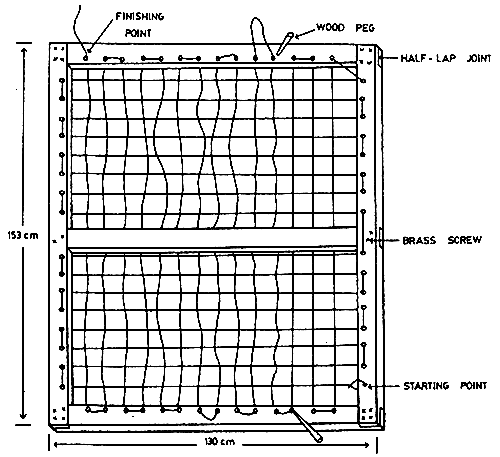
FIG. 1. SCREEN MADE FROM ROPE FOR. MAIN GATE
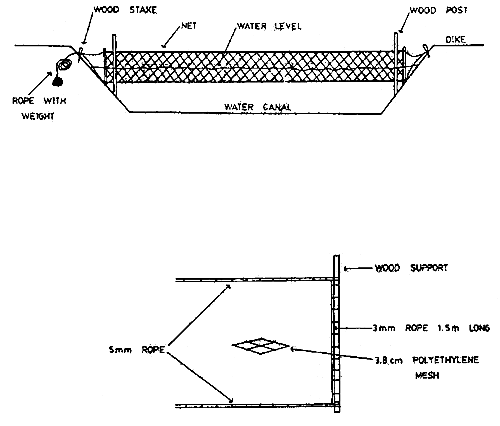
FIG. 2. NET SCREEN FOR MAIN CANAL
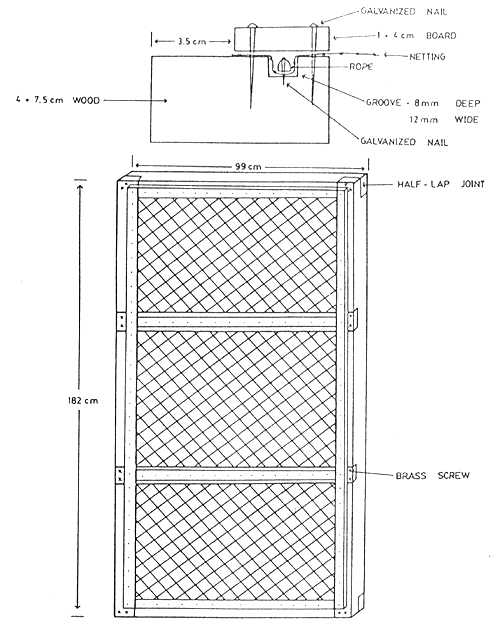
FIG. 3. SCREEN FOR POND GATE
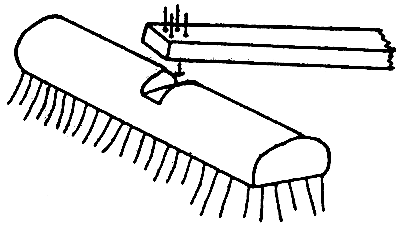
FIG. 4. MODIFIED BRUSH FOR CLEANING SCREENS
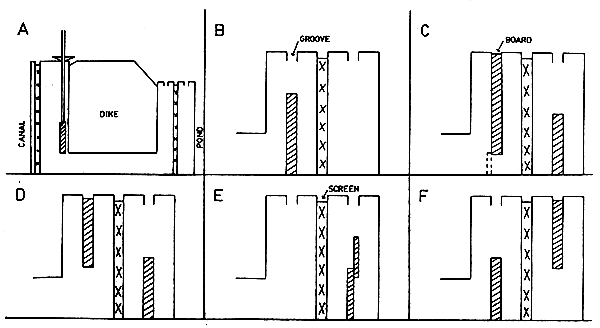
Fig. 5 Monk Type Gate
Culvert type pond gate with two monks
Interior monk with fine mesh screen and board for initial fill up
Interior monk with screen and two boards for water discharge when fry are small
Interior monk with screen and two boards for daily water intake
Interior monk with one board for discharge of surface water
Interior monk with screen and two boards for discharge of bottom water